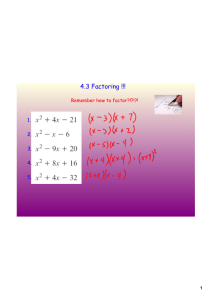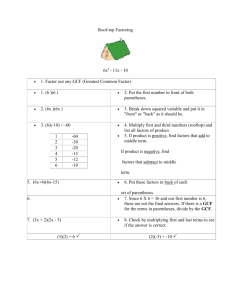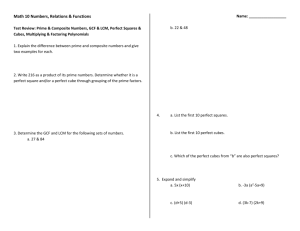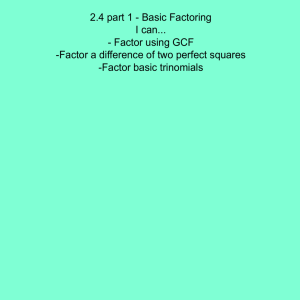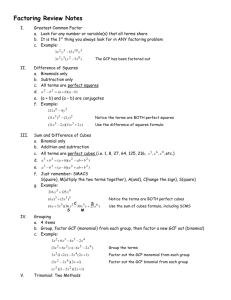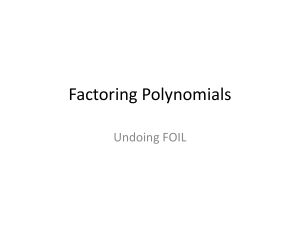2 – d 2
advertisement
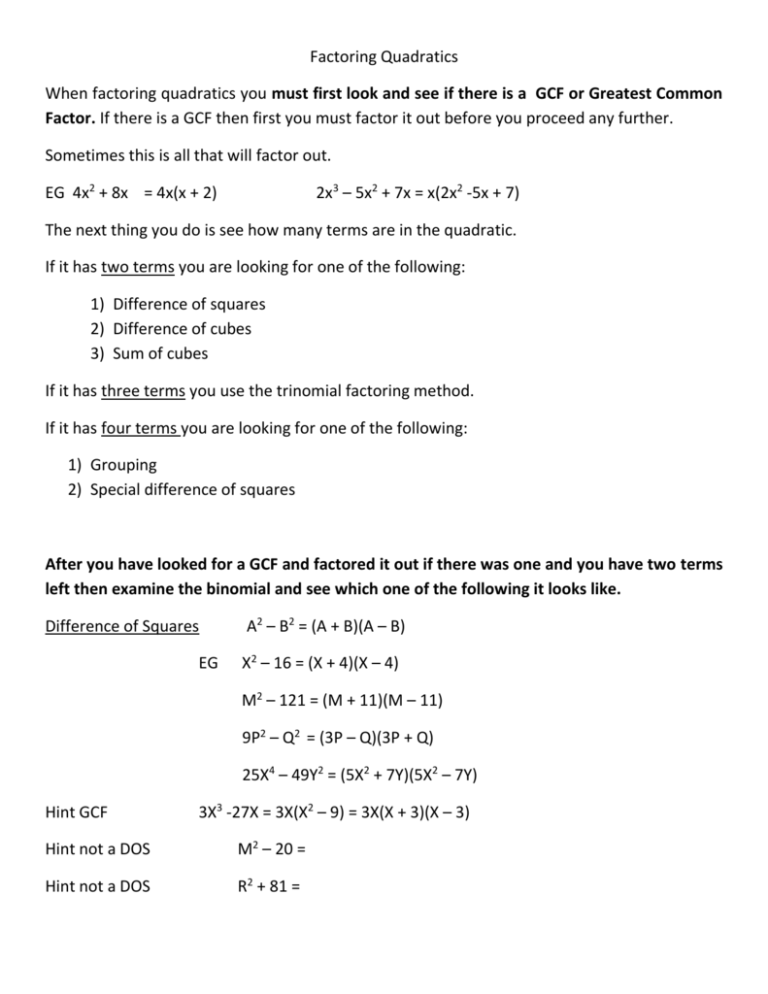
Factoring Quadratics When factoring quadratics you must first look and see if there is a GCF or Greatest Common Factor. If there is a GCF then first you must factor it out before you proceed any further. Sometimes this is all that will factor out. EG 4x2 + 8x = 4x(x + 2) 2x3 – 5x2 + 7x = x(2x2 -5x + 7) The next thing you do is see how many terms are in the quadratic. If it has two terms you are looking for one of the following: 1) Difference of squares 2) Difference of cubes 3) Sum of cubes If it has three terms you use the trinomial factoring method. If it has four terms you are looking for one of the following: 1) Grouping 2) Special difference of squares After you have looked for a GCF and factored it out if there was one and you have two terms left then examine the binomial and see which one of the following it looks like. Difference of Squares EG A2 – B2 = (A + B)(A – B) X2 – 16 = (X + 4)(X – 4) M2 – 121 = (M + 11)(M – 11) 9P2 – Q2 = (3P – Q)(3P + Q) 25X4 – 49Y2 = (5X2 + 7Y)(5X2 – 7Y) Hint GCF 3X3 -27X = 3X(X2 – 9) = 3X(X + 3)(X – 3) Hint not a DOS M2 – 20 = Hint not a DOS R2 + 81 = Differnce of Cubes A3 – B3 = (A – B)( A2 + AB + B2) EG X3 – 8 =X3 – 23 = (X – 2) (X2 + 2X + 4) M3 - 27 = M3 – 33 =(M – 3)(M2 + 3M + 9) 8P3 – 1 = (2P)3 – 13 = (2P – 1)(4P2 + 2P + 1) 27S6 – 64R3 = (3S2)3 – (4R)3 =(3S2 – 4R)(9S4 + 12S2R + 16R2) Hint GCF 3x3 – 24 = 3(x3 – 8) = 3(x3 – 23) = 3(x – 2)(x2 + 2x + 4) Hinf not a DOC w3 – 16 = A3 + B3 = (A + B)(A2 – AB + B2) Sum od Cubes EG X3 + 125 = X3 + 53 = (X + 5)(X2 – 5X + 25) D3 + 216 = D3 + 63 = (D + 6)(D2 – 6D + 36) 8M3 + 27N3 = (2M)3 + (3N)3 = (2M + 3N)(4M2 - 6MN +9N2) W9 + 343 = (W3)3 + 73 = (W3 + 7)(W6 – 7W3 + 49) Hint GCF c5 + 64c3 = c2(c3 + 64) = c2(c3 + 43) = c2(c + 4)(c2 – 4c + 16) After you have looked for a GCF and factored it out if there was one and you have three terms left then use trinomial factoring. Trinomial Factoring Ax2 ± Bx ± C or Ax2 ± Bxy ± Cy2 or Ax4 ± Bx2 ± C or Ax4 ± Bx2y2 ± Cy4 or Ax6 ± Bx3 ± C or Ax8 ± Bx4y3 ± Cy6 Rules for figuring the coefficients are the same no matter which situation you have above. Ax2 ± Bx ± C assuming that A > 0 This sign tells you if you are looking for a sum or difference in the product of the factors of A and C. Ax2 ± Bx ± C assuming that A > 0 B tells you the amount of sum or difference you are looking for. Ax2 ± Bx ± C assuming that A > 0 If it is a sum this sign gives the sign for both factors because in a sum they must be the same. If it is a difference this sign gives the sign of the larger product since they must be different. To really understand trinomial factoring let us look at multiplication first and remember how you use FOIL. (x + 7)(x – 4) = x2 - 4x + 7x – 28 = x2 + 3x – 28 (x + 5)(x + 8) = x2 + 8x + 5x + 40 = x2 + 13x + 40 (x + 3)(x - 9) = x2 - 9x + 3x – 27 = x2 - 6x – 27 (x – 2)(x – 5) = x2 – 5x – 2x + 10 = x2 – 7x + 10 Let us begin x2 + 3x – 28 The – sign in front of 28 tells us we are looking for a difference in the two numbers that make up 28. The 3 in front of x tells us we are looking for a difference of 3. What numbers make up 28? (1x28 or 2x14 or 4x7) The 4x7 satisfies our condition. The + in front of the middle term 3X tells us that the largest factor needs to be positive which is 7. Since it is a difference the other sign needs to be negative. Therefore our answer is (x + 7)(x – 4) X2 + 13x + 40 The + sign in front of 40 tells us we are looking for a sum in the two numbers that make up 40. The 13 in front of x tells us we are looking for a sum of 13. What numbers make up 40? (1x40 or 2x20 or 4x10 or 5 x 8) The 5x8 satisfies our condition. The + in front of the middle term 13x tells us that both factors are positive. Therefore our answer is (x + 8)(x + 5) X2 - 6x -27 The – sign in front of 27 tells we are looking for a difference in the two numbers that make up 27. The 6 in front of x tells us we are looking for a difference of 6. What numbers make up 27? (1x27 or 3x9) The 3x9 satisfies our condition. The - in front of the middle term 6x tells us that the largest factor needs to be negative which is 9. Since it is a difference the other sign needs to be positive. Therefore our answer is (x – 9)(x + 3) X2 – 7x + 10 The + sign in front of 10 tells us we are looking for a sum in the two numbers that make up 10. The 7 in front of x tells us we are looking for a sum of 7. What numbers make up 10? (1x10 or 2x5) The 2x5 satisfies our condition. The – in front of the middle term 7x tells us that both factors need to be negative. Therefore our answer is (X – 2)(x – 5) When there is a number in A position of Ax2 ± Bx ± C. You use the same procedure but now you have to use the factors that make up A and C together to compute the sum or difference number in the middle term. 5x2 + 7x - 6 The – in front of 6 tells us we are looking for a difference with the factors of A and C. The 7 in front of x tells we are looking for a difference of 7. Here are the numbers that make up 3 1 x 5 Here are the numbers that make up 6 1 x 6 or 2 x 3 1x 3 = 3 and 5x2 = 10 give us a difference of 7. The coefficients of x are 1 and 3. (x )(5x ) The 1 goes with a 3 and the 5 goes with a 2. (x 2)(5x 3) The + in front of the middle term 7x tells the largest pairs of factors must be positive which is 5x2. Since it is a difference the other pair of factors must be negative which are 1x3. (x + 2)(5x -3) remember with foil that the outside term is controlled by sign in the second parenthesis and the inside term is controlled by the sign in the first parenthesis. 6x2 – 5x + 1 The + in front of 1 tells us we are looking for a sum with the factors of A and C. The 5 in front of x tells us we are looking for a sum of 5. Here are the numbers that make up 6 1 x 6 Here are the numbers that make up 1 1 x 1 2x3 2x1=2 and 3x1=3 gives us a sum of 5. The coefficients of x are 2 and 3. (2x )(3x ) The 2 goes with a 1 and the 3 goes with a 1. (2x 1)(3x 1) The – in front of the middle term 5x tells us that both factors are negative. (2x – 1)(3x – 1) 10x2 + 7x – 12 The – in front of 12 tells we are looking for a difference. The 7 in front of x tells we are looking for a difference of 7. The factors of 10 are 1 x 10 or 2 x 5 The factors of 12 are 1 x 12 2 x 6 3 x 4 2x4=8 and 5x3=15 gives us a difference of 7 The coefficients of x are 2 & 5. (2x )(5x ) The 2 goes with 4 and the 5 goes with 3. (2x 3)(5X 4) The + in front of 7x tells us the largest set of factors must be positive which is 3x5 and the smallest set of factors which is 2x4 must be negative. (2x + 3)(5X – 4) REMEMBER FOIL After you have looked for a GCF and factored it out if there was one and you have four terms left then decide whether you will group or use a special difference of squares. Special Difference of squares looks like Ax2 ± Bx + c2 – d2 = (√𝑨𝒙 + 𝒄2)2 – d2 = (√𝑨x ± c + d)(√𝑨x ± c – d) The 1st,3rd,& 4th terms must all be perfect squares. Also B = 2(√A)(c) X2 – 6x + 9 – y2 =(x – 3)2 – y2 = (x – 3 + y)(x -3 – y) X2 + 10 x + 25 – 4x4 = (x + 5)2 – 4x2 = (x + 5 + 2x2)(x + 5 – 2x2) 9b2 – 42bc + 49c2 – 169 = (3b – 7c)2 -169 = (3b – 7c + 13)(3b -7c – 13) 1. X2 + 16x + 64 – y2 2. X2 – 12x + 36 – 9m2 3. 4m2 – 4m + 1 – 25n2 If you have four terms and they do not fit the special difference of squares then you group the first two terms and pull out a GCF and then group the last two terms and pull out a GCF. Once you do this you should have the same binomial left after you have pulled out the two GCF’s. EG x2 – 4x + bx – 4b EG 3x + 15 +x2 + 5x EG 5x – x2 + 10 – 2x X(x – 4) + b(x – 4) (x – 4)(x + b) 1. 2xy -12x + 3y – 18 4. 2bc – 4b + 3c – 6 3(x + 5) + x(x + 5) x(5 – x) + 2( 5 – x) (x + 5)(3 + x) 2. 5. (5 –x)(x + 2) X3 + 5x -2x2 – 10 4b + 12 – ab – 3a 3. EG ab – 4b -2a + 8 b(a – 4) -2(a – 4) (a – 4)(b – 2) 5n -2nm + 15p -6pm 6. X3 – x2 + 2x - 2
